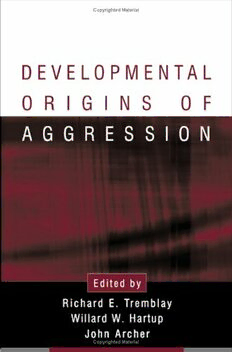
Developmental Origins of Aggression PDF
497 Pages·2005·2.125 MB·English
Most books are stored in the elastic cloud where traffic is expensive. For this reason, we have a limit on daily download.
Preview Developmental Origins of Aggression
Description:
While aggression is often conceived as a learned behavior that peaks during adolescence, this important volume shows that aggressive behaviors have their origins in early childhood and even infancy. Findings from major longitudinal research programs are used to illuminate the processes by which most children learn alternatives to physical aggression as they grow older, while a minority become increasingly violent. The developmental trajectories of proactive, reactive, and indirect aggression are reviewed, as are lessons learned from animal studies. Bringing together the best of current knowledge, the volume sheds new light on the interplay of biological factors, social and environmental influences, and sex differences in both adaptive and maladaptive aggression.
See more
The list of books you might like
Most books are stored in the elastic cloud where traffic is expensive. For this reason, we have a limit on daily download.
